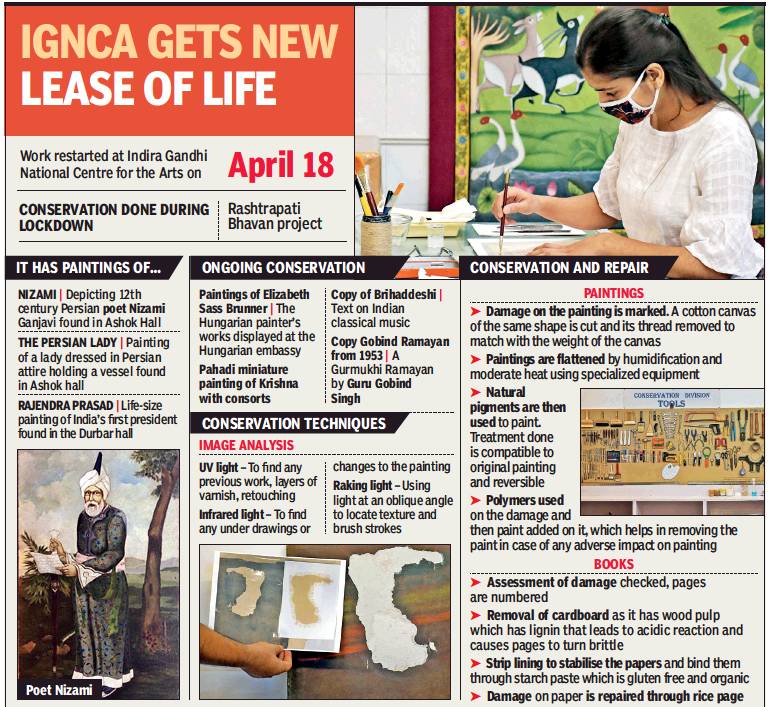Indira Gandhi National Centre for the Arts
This is a collection of articles archived for the excellence of their content. |
Restoration of artworks
As in 2020
Mohammad Ibrar, November 22, 2020: The Times of India

From: Mohammad Ibrar, November 22, 2020: The Times of India
There is one group that has kept on working through the restrictions placed by the Covid-19 pandemic: conservation experts at Indira Gandhi National Centre for the Arts (IGNCA). Having worked on the preservation of important artefacts and items, including a 300-year-old Arunachal Pradesh manuscript and Rashtrapati Bhavan paintings, they are currently involved in the restoration and conservation of the paintings of Hungarian-Indian artist Elizabeth Sass Brunner.
The conservationists have been extra careful to use natural pigments, organic solvents, rice paper and starchbased adhesives to repair the tear in old books and documents. “When we resumed work on April 28 after the lockdown, we had a strict twice-a-week sanitisation policy, though we also had 10 conservationists working through the lockdown,” said Achal Pandya, head of conservation, IGNCA. “Because we have enough space, social distancing wasn’t a problem.” The team are restoring some works of Brunner, the Hungarian artist who came and worked in India over half a century ago. “The Hungarian embassy sent us two of her paintings that needed help. One of them is called Mother and Child,” said project associate Anil Dwivedi.
Dwivedi explained that the restorers “mark the damage and recreate the portion by using cotton threads to match the weight of the original canvas, after which the starch is removed from the canvas and natural pigments used”. He said, “Our purpose is to use treatment that is compatible and reversible.”
The team uses polymers to ensure the artwork doesn’t get adversely affected during the treatment. “We employ polymers such as Paraloid B72, Paraloid B67 and other adhesives depending on the sensitivity of the painting,” Dwivedi pointed out. “The retouching fills in the lost pigments and recreates the texture of the painting. However, we do not recreate the damaged section perfectly, making sure it is visible to a professional from a distance. Recreating things perfectly is an offence.”
Other conservationists are also busy. Simran Sangal, for instance, is restoring a miniature Pahadi painting depicting Krishna with his consorts. “The pigment on the painting has been converted over the years from the red-coloured lead oxide to black-coloured lead sulphide. We are using diluted bleaching to recreate the original colour,” she said.
Cleaning art works is another important function at IGNCA. “The process follows a set of principles. We use water-based cleaners like ammonia water for dealing with varnish that has become oxidised over the years,” said Dwivedi. Before any cleaning starts, the paintings undergo ultraviolet, infrared and raking light analyses to expose show previous restorations, varnish layers, under-drawings, textures and brush strokes. Pandya said that many books also come to IGNCA for restoration and preservation. “We get damaged books from the archives and libraries. We have our own binding method, which makes the books strong enough to bear wear and tear,” said Pandya.
Conservationist Pooja Khandekar is busy documenting a copy of the Sanskrit text Brihaddeshi. “After documenting the book, picture, annotating the pages and noting its problems, we consider the treatment it requires,” she said. Dwivedi explained that old books have papers that have acidified and become brittle. “Wood pulp paper has a high presence of lignin, which eventually turns acidic and prone to tears,” he elaborated. “We remove the cardboard and replace it with acid-free mount board to prevent future damage. We bind the papers with a starch paste that is gluten-free and organic. Any damage on the pages is repaired using rice paper because its thickness suits the restoration.” Pandya is proud not to have let the coronavirus disrupt work. “The pandemic did not deter us,” he said, intent on protecting India’s cultural heritage.